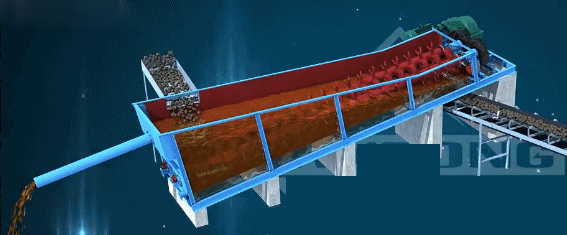(This post does not intend to change anything, it is just a curious question)
Most machines in the GT6 can find their real-world prototypes and principles. After I figured out the principles of many machines, I became interested in the principles of GT ore washing machine, so I searched for some information.
In reality, ore washing machines are generally divided into two types: drum ore washer and spiral ore washer. There are significant differences in the structure of these two types of ore washing machines, but their working principles are the same: they use density differences to separate main minerals and byproduct minerals from impurities such as sediment and gangue through the buoyancy and scouring of water, in order to facilitate subsequent mineral processing.
The drum washing machine is composed of a drum with an internal spiral lining plate. After minerals enter from one end, they are driven by the internal lining plate to move towards the other end. At the same time, they are constantly stirred by the lining plate and washed away by the water flow input from one end. During this period, due to density differences, impurities such as sediment that are easily suspended in the water will be carried by the water flow at the filter screen at the other end as wastewater, while the washed ore will be discharged from the other end. The direction of water flow and the direction of ore movement are sometimes the same, sometimes opposite (in this animation, the direction of water flow and ore is the same, it seems that different minerals will be different).

The spiral ore washing machine uses one screw or two opposite rotating screws to drive the ore forward and slowly rise in a long groove. The water flow washes the ore from the opposite direction of movement to remove impurities in the ore. The spiral washing machine utilizes the buoyancy of water to separate dust and impurities from sand and gravel. After stirring with spiral blades, the purpose of filtering water and removing impurities is achieved. The spiral washing machine forms a sedimentation tank under an inclined water tank, and the spiral head does not enter the sedimentation tank. The screw is driven by a motor deceleration,Wastewater is discharged from the bottom of the sedimentation tank, completing three major functions: cleaning, dehydration, and grading. (In the animation, it is a double spiral ore washing machine)

I watched the animation of the GT6 sluice, and it seems that it is not similar to either of the two. The structure of the large sluice looks somewhat similar to the slot type spiral ore washing machine, but its ore and water are input and output in the same direction, which is different from the spiral ore washing machine, and the working animation also looks different. And regardless of the type of ore washing machine, in reality, the power is always from the front or rear, not from the side (although this may also be for the convenience of input and output design), and it cannot be seen from the recipe. For the animation and recipe of the IC ore washing plant and the previous versions of the GT ore washing plant, it cannot be determined. So can you explain which type of washing machine in reality was used as the prototype when conceptualizing? @Gregorius